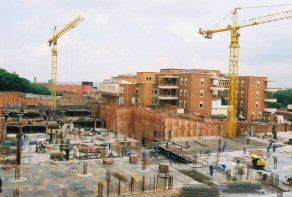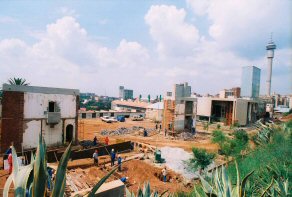Since the custody of materials in the archive of the Constitution Hill Trust has been taken over by the South African History Archive (SAHA), the archival team has completed the first phase of the processing of the materials now known as the Constitution Hill collection - a collection that relates as much to the history of the site, as it does to the vision, development and construction of the Constitutional Court, and the conceptualisation and development of Constitutional Hill as a heritage site.
 Whilst the collection is now open for research, the collection inventory remains a work-in-progress which will develop when additional work on the collection commences during phase two. Work in the second phase will include the cataloguing of the museum objects, item level archival description and revising agreements with stakeholders to further facilitate access and use.
Whilst the collection is now open for research, the collection inventory remains a work-in-progress which will develop when additional work on the collection commences during phase two. Work in the second phase will include the cataloguing of the museum objects, item level archival description and revising agreements with stakeholders to further facilitate access and use.
Located at SAHA's offices at the Women's Jail, this archival collection contains documents, correspondence, publications, and photographs that trace the history of the making of Constitution Hill. The collection spans the time from when it was first suggested to turn the entire site into a heritage site in the 1980s, to the opening of the complex and the Constitutional Court in 2004, and beyond.
Research undertaken by the Heritage, Education and Tourism (HET) team in order to conceptualise the key points of the site that could be included in a programme of permanent exhibitions into the site's history and the early history of Johannesburg, is recorded in the form of articles, historic photographs and reports. This research spans the use of the Fort from when it was constructed under the instruction of Paul Kruger, president of the Zuid-Afrikaansche Republiek (South African Republic) in 1893, to its occupation by the British army during the South Africa War in 1900, to its use as a prison during Apartheid where political prisoners like Henry Nxumalo, Nelson Mandela, O.R Tambo, Barbara Hogan, Winnie Mandela, and Albertina Sisulu were held.
Collection materials which relate to the construction of the Constitutional Court and the transformation of the site from the beginning of construction in 2002 to the completion in 2004, include documents on the architectural competition for a new Constitutional Court building, proposals, some site plans and presentation files that were used by the architects, construction companies and planners, as well as a large collection of site photographs. Organisational documents like reports, minutes, tenders, business and funding proposals that trace the planning on various levels, from various teams and organisations can be found in the collection, as well as materials relating to Constitutional Hill public programmes from 2004 to 2007.
 Prisoner narratives form a particularly important part of the collection. The HET team that was commissioned to coordinate and implement the museum exhibitions on display at the Fort and Number Four conducted research into the personal narratives of criminal and political male and female ex-prisoners held at Number Four and the Women's Jail. These stories are important in understanding the processes of arrest and unfair trial during the apartheid era; the prison conditions of black inmates; and the relations to warders. Interview transcripts, video interviews, and ex-prisoner workshop transcripts form part of the collection. An extensive number of these documents relate to the Women's Jail. Some of the ex-female prisoners still meet on a weekly basis and SAHA is in the process of working with these women on updating and legitimising the collection.
Prisoner narratives form a particularly important part of the collection. The HET team that was commissioned to coordinate and implement the museum exhibitions on display at the Fort and Number Four conducted research into the personal narratives of criminal and political male and female ex-prisoners held at Number Four and the Women's Jail. These stories are important in understanding the processes of arrest and unfair trial during the apartheid era; the prison conditions of black inmates; and the relations to warders. Interview transcripts, video interviews, and ex-prisoner workshop transcripts form part of the collection. An extensive number of these documents relate to the Women's Jail. Some of the ex-female prisoners still meet on a weekly basis and SAHA is in the process of working with these women on updating and legitimising the collection.
The collection also holds various historical documents, including correspondence by ex-prisoners of the Fort and the Women's Jail such as Barbara Hogan, Esther Barsel, and Eli Weinberg, Violet Weinberg and Sheila Weinberg. Fatima Meer's original drawings and paintings of everyday life in the Women's Jail are also kept in the archive.
Museum objects that were commissioned and donated by various institutions and stakeholders can also be found in the collection. Items include warder uniforms, personal items donated by ex-prisoners, and soap, blanket and paper mache sculptures created by male ex-prisoners for exhibition purposes.
View the Constitution Hill Collection AL3295
Visit the Constitution Hill Trust website
Visit the Constitutional Court website





 Whilst the collection is now open for research, the collection inventory remains a work-in-progress which will develop when additional work on the collection commences during phase two. Work in the second phase will include the cataloguing of the museum objects, item level archival description and revising agreements with stakeholders to further facilitate access and use.
Whilst the collection is now open for research, the collection inventory remains a work-in-progress which will develop when additional work on the collection commences during phase two. Work in the second phase will include the cataloguing of the museum objects, item level archival description and revising agreements with stakeholders to further facilitate access and use. Prisoner narratives form a particularly important part of the collection. The HET team that was commissioned to coordinate and implement the museum exhibitions on display at the Fort and Number Four conducted research into the personal narratives of criminal and political male and female ex-prisoners held at Number Four and the Women's Jail. These stories are important in understanding the processes of arrest and unfair trial during the apartheid era; the prison conditions of black inmates; and the relations to warders. Interview transcripts, video interviews, and ex-prisoner workshop transcripts form part of the collection. An extensive number of these documents relate to the Women's Jail. Some of the ex-female prisoners still meet on a weekly basis and SAHA is in the process of working with these women on updating and legitimising the collection.
Prisoner narratives form a particularly important part of the collection. The HET team that was commissioned to coordinate and implement the museum exhibitions on display at the Fort and Number Four conducted research into the personal narratives of criminal and political male and female ex-prisoners held at Number Four and the Women's Jail. These stories are important in understanding the processes of arrest and unfair trial during the apartheid era; the prison conditions of black inmates; and the relations to warders. Interview transcripts, video interviews, and ex-prisoner workshop transcripts form part of the collection. An extensive number of these documents relate to the Women's Jail. Some of the ex-female prisoners still meet on a weekly basis and SAHA is in the process of working with these women on updating and legitimising the collection.